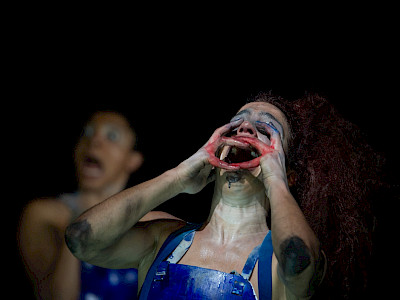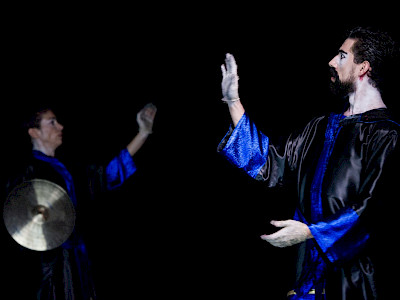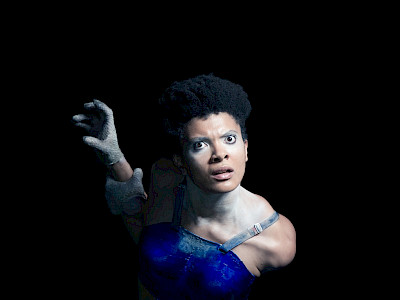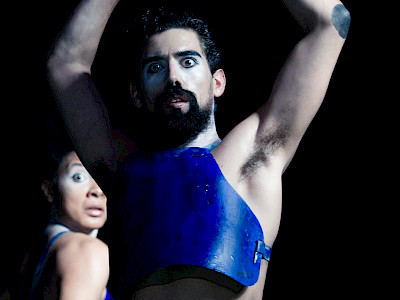09 — 12.05.2015
Born in Cape Verde, a former student at P.A.R.T.S. in Brussels and now based in Lisbon, dancer and choreographer Marlene Monteiro Freitas is one of the most exciting new talents of her generation. Her latest creation is a stunningly inventive and positively dazzling show. A “grotesque ball” of mechanical puppets or stone statues that come to life against a background of shrill and percussive music, de marfim e carne (of ivory and flesh) reveals a very personal world filled with references passing by at full speed. References – think of the modernist avant-gardes of the early 20th century in particular – whose ambiguity however is exposed in contemporary issues. Like an echo of Pygmalion breathing life into his statue of Galatea, the choreographer seems to be suggesting that only sensitivity, desire and love can stop our bodies from becoming enslaved. Well worth seeing!
of ivory and flesh
statues also suffer
Four characters-performers dance to the hieratic immobility of statues, figures imprisoned within their own limits. These are grotesque and motionless figures in motion, open to the infinity of the imagination; that is to say, open to desire – the core of the project.
Movements, gestures, and moods are composed in a particularly precise, detailed, obsessive manner, in a strained dialogue with the music, as if the figures are taking part in a ball already very familiar to them, dancing and keeping pace with every variation in the music, no matter how strange and improbable it may look.
Balls are possible metaphors for movement: statues of stillness, petrification of the transformation of humans into statues. The latter corresponds to being anchored to the place where it occurs, thus it describes the strangest metamorphosis into movement and the most contradictory idea of a ball. The entanglement of ideas such as visibility, mobility, animation, resurrection, mechanism, image and its double: icon, desire, incarnation… will bring us into the territory of hybridism.
On stage, three musicians play the cymbals. They alternate between a classic or a jazz ensemble and ‘mechanical toy soldiers’, clock-men, saw-craftsmen, birdmen, among other hybrids. They may as well be present as simple, geometric figures, as décor – the engine that sets the music and figures in motion, and part of the show’s set up, in this case a live one.
The musical director is the only permanent element in the musical ensemble, and furthermore, he alternates between the roles of conductor, player, and dancer at the ball. The two musicians will not be permanent parts of the cast but rather musicians, students, or amateur musicians willing to join the show on the occasion of each new production.
de marfim e carne – as estátuas também sofrem relates to the myth of Pygmalion, about a man who crafted a statuette through his desire, music, and offerings to Venus, then ends up animating it, and finally falls in love and marries it/her. At last, he realises she is not a woman, but a simple statuette. This myth is a transgression, a poetic transformation from bone to flesh, from white to red, from hard to soft, from death to life.
As in Ovid’s Metamorphosis, the story of Pygmalion develops within the myth of Orpheus, as a song of hope for resurrection. He sings after losing Eurydice, who is petrified by the gaze of her husband. It is a story inside a story. Orpheus, the focus of the Bacchantes and the man who entered Hades, tells us a story of transgression that defies death and the limitations of Earth.
Hybrids are the ones who transgress categories, who conjunct species, who combine life and death in their nature, as much as statues do. Stone, wax, wood, metal, or any other material, have served man to create bodies, figures, mechanisms (puppets)… physically and emotionally crafted, modelled, ultimately signifying forms of the virtual world, disfigured or embellished, deified or freely fantasised, in order to simulate life and trick death.
The subtitle of this project is also related to the title of Alain Resnais and Chris Marker’s Les statues meurent aussi (Statues also die) of 1953, a commission by Présence Africaine, a Parisian magazine. Within the framework of our project, bodies-statues ‘suffer from reminiscences’, meaning that symptomatic bodies or gestures become reminiscent of invisible, not sequential, events and are accompanied by strong emotional intensity.
Our ball is a luminous-obscure place, thought to be a receptacle for ghosts and like the plinth of an ivory statue, delicate but not fragile, that retains in its nature much of life and of death.
Interview with Marlene Monteiro Freitas
“It’s about a ball, so people are dancing”
What was the starting point for your new creation de marfim e carne – as estátuas também sofrem (of ivory and flesh – statues also suffer)?
Inanimate material, stone, bone, ivory made flesh, living and petrification. The myths of Pygmalion and Orpheus are echoed in these conditions: led by desire, a man defies the limits of what is living and dead. In the desire for metamorphosis, for otherness, for hybridity, we wanted to create a ball featuring petrified beings.
Your previous piece had its roots in the paintings of Lucas Cranach, Jan Van Eyck and Francis Bacon. What inspired this new work?
Our initial inspiration was the documentary Statues Also Die by Alain Resnais and Chris Marker. The film’s aesthetics caught our attention: the succession of masks, the chosen shots, the intensity of the music and light, the proliferation of the narrator’s words, the breaks… these elements gave the film-maker an animist power: he brings to life objects who have the power of exchange and sharing. The film creates a relationship between several aspects of “African art”, colonialism and its after effects. I was inspired a great deal by some of the figures in the films Vertigo by Alfred Hitchcock and Persona by Ingmar Bergman. It also contains fragments from Monteverdi’s Orpheus and Jean Cocteau’sTestament of Orpheus, echoing lots of our research on metamorphoses etc.
How did you create the performance out of this research?
We worked on dichotomy: visible and invisible, presence and absence. By states or actions of varying precision, we tried to make events, spaces and new figures appear. We worked on shifting these intensities, as in dreams where the affects and emotions aren’t in harmony with the gestures or events being experienced. It’s about a ball, so people are dancing, singing, eating, playing music and going to the toilet. Some fall asleep, dream, make speeches. There are homages to absent people, accidents, breaks… the musicians follow one another according to the musicians’ or the DJ’s mood. The music, the images, the ideas, the myths are just the base on which to place our statue. Because on stage it’s just the outcome of a process of transformation, of condensation. This is how the images survive in our bodies and in our presence.
The soundtrack is quite dominant throughout. How did you choose the music?
There’s recorded music and live music. The pieces we’ve chosen all contain references to love, intimacy, desire and transgression. The soundtrack features hits by Omar Souleyman, Arcade Fire, Nutcracker, Tchaikovsky, Monteverdi and Bachar Mar-Khalifé. A buzz can be heard at irregular intervals during the performance. There’s also live music: percussionists play the cymbals, there are multiple condensed figures who indirectly lead the dancers towards different situations. Animation and resurrection are two sides of the same mirror. We end the show with a reprise of Feelings. Sung by Nina Simone, this love song becomes a petrified shout, a shout of transgression.
We also rediscover certain elements in this new work from your previous show paraíso – colecção privada: the tattoos, the wide-eyed stares, the big open mouth… Do they have a particular significance?
The wide-eyed stares are a result of our work on petrification; the big open mouth is a hole. Our costumes are fencing gear that we painted blue. Our stockings are painted black, echoing the long songs worn by fencers.
Choreography
Marlene Monteiro Freitas
Performance
Marlene Monteiro Freitas, Flora Detraz, Andreas Merk, Betty Tchomanga, Lander Patrick, Cookie (percussion), Tomás Moital (percussion), Miguel Filipe (percussion)
Light & space
Yannick Fouassier
Music
Cookie (percussion), Tiago Cerqueira (editing & sound)
Research
João Francisco Figueira, Marlene Monteiro Freitas
Distribution
Key Performance (Stockholm)
Acknowledgements
Staresgrime, Dr. Ephraim Nold
Presentation
Kunstenfestivaldesarts, Charleroi Danses/La Raffinerie
Production
P.OR.K (Lisbon)
Co-production
Kunstenfestivaldesarts, Bomba Suicida (Lisbon), Festival Montpellier Danse 2014, Alkantara (Lisbon), Centre Pompidou (Paris), Centre chorégraphique national Rillieux-la-Pape, Musée de la danse, Centre chorégraphique national de Rennes et de Bretagne, WP Zimmer (Antwerp), Teatro Maria Matos (Lisbon), ARCADI, Centre de développement chorégraphique de Toulouse Midi-Pyrénées, Théâtre national de Bordeaux en Aquitaine
With the support of
O Espaço do Tempo (Montemor-o-Novo), ACCCA – Companhia Clara Andermatt
This project is co-produced by
NXTSTP, with the support of the Culture Programme of the European Union






